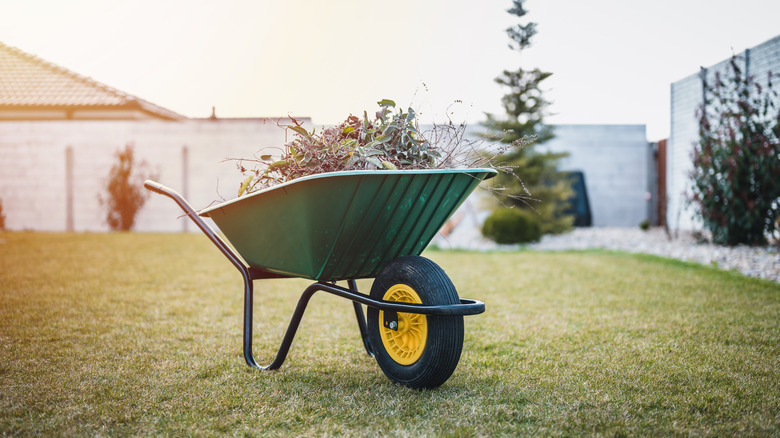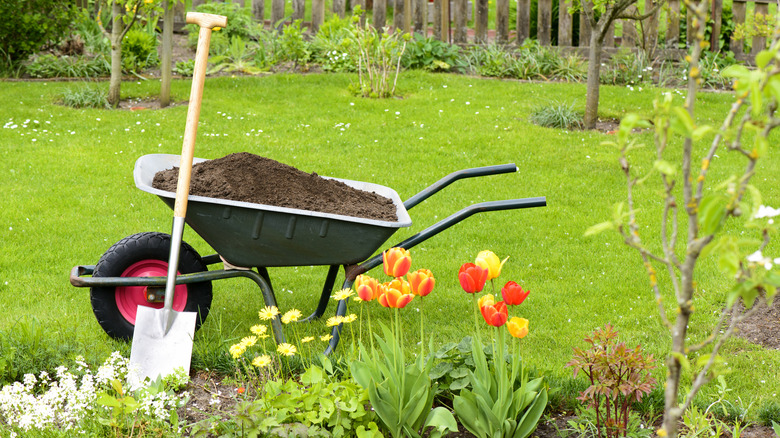How To Choose The Perfect Wheelbarrow For Gardening
A staple in any garden, a wheelbarrow is a critical tool for taking care of the yard, allowing homeowners to keep their outdoor spaces tidy and spruce up their curb appeal. Wheelbarrows serve many purposes from helping clean up fallen leaves in autumn to helping craft a dream landscape in your front yard. So, it's important for gardening enthusiasts to pick the right wheelbarrow for their specific home and garden in order to reap the most benefits from their investment.
Wheelbarrows come in all shapes, sizes, and colors nowadays, and with each style comes its own set of advantages and downsides. Gardeners can choose their ideal wheelbarrow by taking into consideration the characteristics of their yard as well as their personal preferences. Whether you're a gardening novice or a seasoned pro, a proper wheelbarrow can make tending to your yard quicker and easier. Here's how to pick the perfect wheelbarrow for you and your garden.
Consider your yard and mission
Gardeners use wheelbarrows to transport a variety of objects around their yards including leaves, soil, and landscaping materials. Each of these differ greatly in weight and mass, so determining what you'll use your wheelbarrow for can help you pick the right model. The base or bucket of a wheelbarrow can be found in steel or plastic. Steel is much more durable when compared to plastic, meaning a metal wheelbarrow can carry heavier objects more effectively than its plastic alternative.
The shape, steepness, and terrain of your yard or garden will impact your wheelbarrow model of choice. With a classic wheelbarrow, you rely on a singular wheel and two handles to maneuver it around, so the landscape matters a great deal. For example, pneumatic wheelbarrows, models with air-filled tires, shouldn't be used regularly in a yard with especially rocky and sharp terrain. The tires could easily puncture as a result. Opt for a wheelbarrow with solid rubber tires instead, even if these varieties lack overall quality in comparison to pneumatic wheelbarrows. On another note, if you have a relatively flat and easy to maneuver landscape, you may look for a model with two wheels that will offer more stability.
Consider comfort and personal health
Because wheelbarrow models differ so greatly nowadays in terms of make and design, they also feel quite different when being used. Think of your physical condition when choosing a wheelbarrow, including personal strength, endurance, and agility.
Handles play a large role in ease of movement. Most models come with two handles made of wood, while some come with only one handle. Wheelbarrows with a single handle can make pulling and dumping easier for users, but the additional handle may prove beneficial to those who struggle with balance. Handles with rubber or plastic grips may be kinder to hands than would traditional wooden options, which can cause splinters and overall roughness if not used with work gloves. Steel-handled models also exist for gardeners wanting a sturdier grip.
As for wheels, wheelbarrows can come with one, two, or four. The additional tires generate more stability across the base, which can ultimately make the wheelbarrow easier to push. Though, gardeners would be sacrificing maneuverability for steadiness, since it's easier for a one-wheeled wheelbarrow to turn at sharp angles than it is for one with multiple wheels. Naturally, heavier models are harder to push, especially when traveling uphill against the force of gravity. Consider a lighter model consisting mostly of plastic if only engaging in light gardening, as using it may prove to be better for your back, especially when working long hours.


